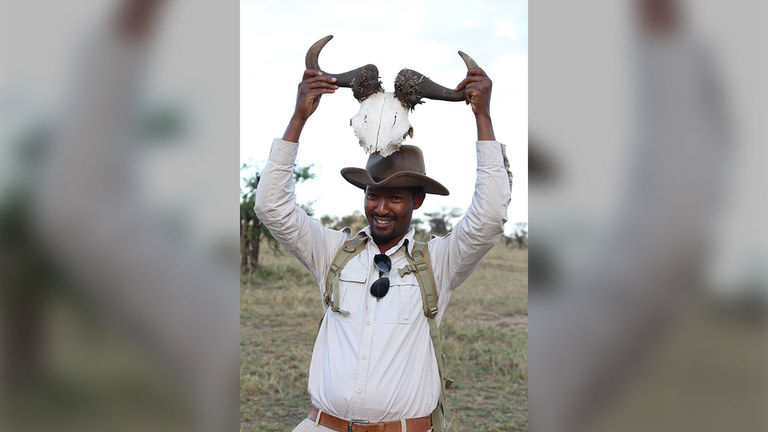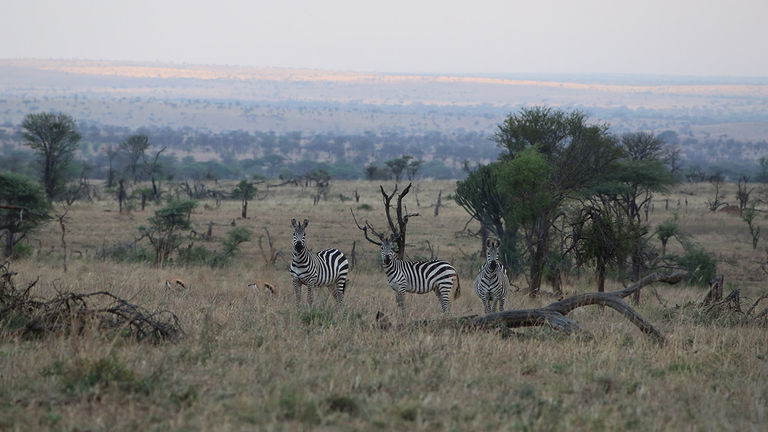“Act like an herbivore,” instructed Isack, our guide for our week at Four Seasons Safari Lodge Serengeti in Tanzania.
As a vegetarian, I felt like I might have an advantage over the rest of my group, but he wasn’t talking about what we were going to be eating over the next hour and a half.
Instead, he was referencing the behavior that helps prevent Serengeti National Park’s plant-only eaters from hanging limp over a tree branch.
After a few motorized game drives, our group was eager to experience the Serengeti by foot. We proceeded to make like elephants and zebras and walk single file through the bush. Predators tend to target animals that stray from their pack, Isack told us.
We had an edge over the less fortunate creatures we had witnessed in the park, such as a baby gazelle (a cheetah’s snack) and a lion cub (a rare meal for a lucky leopard). In addition to Isack, our group of five was joined by Kassi, a Maasai, and two armed Tanzanian park rangers who created a protective buffer around our group by walking far ahead and behind us.
 Armed park rangers ensure the group’s safety as they walk through the Serengeti.
Armed park rangers ensure the group’s safety as they walk through the Serengeti.
Credit: 2018 Mindy PoderPlus, we were decked out with the kind of swag that only Four Seasons would thoughtfully prepare: a beaded Maasai tag with what looked like a zebra tail (to swat flies); a skinny, wooden stick resembling what the Maasai use to prod cattle, kill snakes and, of course, walk; and a khaki cross-body tote to fashionably and efficiently carry our water bottles.
It was the Serengeti’s dry season — the best time to spot animals — and patches of blondish-green grass crunched under the weight of my feet.
Unlike in a game drive, my eyes were focused on the ground. By car, the plains looked, well, plain — but now, we could barely take a step without Isack pointing out the many artifacts that animals left behind.
First, we encountered a bouquet of aged pellets (impala poop), followed by large wet circular mounds (buffalo poop). The most interesting part of the “scat safari”— as our group nicknamed this part of our walk — was the hyena’s chalk-white remnants, proof of their scavenger nature and diet of bones.
We also found two hartebeest carcasses and learned that their horns play a crucial role in the procreation of moths.
 Four Seasons guide Isack holds up a hartebeest carcass and explains its uses.
Four Seasons guide Isack holds up a hartebeest carcass and explains its uses.
Credit: 2018 Mindy PoderJust as I became lost in the emotional arcs of “Circle of Life” looping in my head, as though I was walking through a scene of “The Lion King,” Isack brought me back to the present moment.
Pointing to fur on the ground, he asked us what we thought happened.
“A kill?” I inquired, ever the diligent and skittish herbivore.
Nodding, Isack turned to face an adjacent tree and instructed us to look up.
Squinting, I noticed that something wasn’t quite right with one of the branches. It appeared more mangled and less curvy. Then, the truth dawned on me: Those were actually bones, which belonged to a gazelle that had lost its fight with a leopard.
Isack had witnessed the takedown just a month before. It was one of many special moments we could credit to his experience and passion for guiding.
Kassi provided a unique perspective on the Serengeti’s surroundings, too. Gathering our group around a sandpaper tree, he encouraged us to rub the fat, circular leaves on our hands to understand how the tree got its name. He explained that Maasai boil the petals in a tea for pregnant women, among other uses.
The sun began to set beyond the horizon — the destination for the antelope, zebras and wildebeest we spotted throughout our walk, who, like true herbivores, wanted nothing to do with us. A van appeared and whisked us past the Four Seasons to an intimate location in the adjacent plains, centered around a large, iconic acacia tree.
 Worry not — animals tend to keep their distance from humans.
Worry not — animals tend to keep their distance from humans.
Credit: 2018 Mindy PoderIt was now dark, but the tree’s bark — a perfect “V” shape — had been decorated with bright lanterns. Under the glowing branches, a server awaited us with glasses of wine and champagne. As our crew of chefs and servers prepared a feast for us, we sat around a bonfire, breathing in the night air and taking in our surroundings — illuminated by the fire, as well as our newfound knowledge.
Other Unique Must-Dos at Four Seasons Serengeti
- The property’s Discovery Center, headed by the on-site naturalist, is full of maps and illustrated factual posters as well as a chest full of real artifacts including skulls and scat.
- Constantly voted one of the best pools in the world, the property’s main pool is located above a watering hole that attracts a herd of elephants that may visit several times a day in the dry season.
- Join the property’s resident yogi, a Maasai warrior and a Serengeti ranger at sundown for a meditation on the property’s highest kopje (or hill), where the only challenge is to keep your eyes closed as the sky changes colors over the Serengeti plains.
- Don’t feel guilty about arranging spa time here. Many of the treatments use local ingredients such as baobab, Africa’s tree of life, for a bit of education with your relaxation.
The Details
Four Seasons Safari Lodge Serengeti
www.fourseasons.com/serengeti